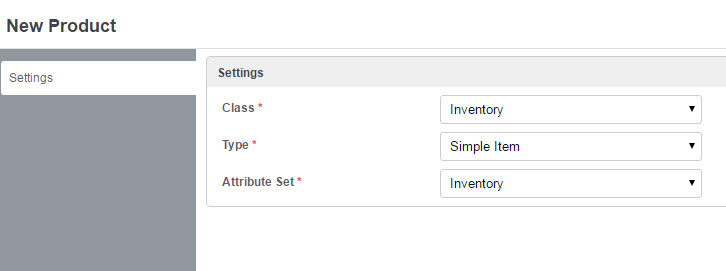Create Simple Product

Steps
- Select Inventory or Non-Inventory product - Inventory is for things you track, Non-Inventory is for fees, labor and other charges as well as things you don't think are worth tracking.
- Select an attribute set that contains the fields you need for this product. The standard inventory attribute set is sufficient for many products.
- Provide the product with a SKU that is unique and a unique, descriptive Item Name. Optionally you can also enter a Style - if your product also has a Style Name. All these fields are used when searching for products. More search and id fields are available under the alternate ID's tab.
- Enter the cost and markup (GP%) or the Price (these fields will adjust as you change them to show the correct markup percent).
- Supplier is optional, so is brand but if you wish to use the Purchase orders and supplier shipments modules you need to add a main supplier. Alternate suppliers are handled on the Alternate ID's tab.
Categories
- Select the main category and any subcategories for this item in the left panel (this left panel is important for reports, export to accounting and stock tracking and analysis). On the right select all categories that apply to this panel (this right panel is important for customer navigation on your web site).
- Add any tags you wish to assign to this products - tags can be used on your web site and promotions to quickly locate a group of otherwise unrelated products or to assign qualities to a product that are not part of your category or attribute fields (things like 'pet safe', 'made in usa', 'eco rebate', and so forth can be assigned here.
Settings

-
This tab contains many flags that change the behavior of the product in your system:
- Enabled - if product is disabled it disappears from all searches and cannot be used but will show up in reports.
- Include in QP Panel & Panel Location
- Do Not Discount - will not be allowed on a promotion nor can it be discounted in the Front Register.
- Qty Uses Decimals - allows fractional entry of quantity such as 1.6 meters of fabric or 2.5 hours of labor.
- Accept Returns - default yes, unchecking will prohibit returns at the register.
- Qty Increments - if you need to enforce an 'always sell 2' or increments of .25 for fractional items.
- Automatic Order - used by reorder tools to automatically reorder items below restock threshold.
- Default Tag Format - format that will be used in tag print for this item unless another is selected.
- Weight - item weight (shipping and future use).
- Volume (shipping and future use).
- Minimum supplier order - if the main supplier requires some number of these for a reorder such as min order '6' - buyer will be alerted in purchasing module.
- Discontinued - continues to show up in searches and can be sold, received, transferred and placed on promotion but can no longer be ordered.
Prices

- In this tab you can change the price by store for an item. If you have different prices in different groups of stores you can select one or more stores and change the price.
- You can also add the new item to any existing promotions, customer pricing or quantity based pricing.
Inventory
- This displays the current stock and reorder information for your stores as well as providing a way to set the reorder levels and the opening stock balance and value.
- To set the opening stock balance select any number of stores that will be set the same and enter the beginning stock balance. If you wish you can change the value (cost) of the stock.
- To set the reorder level select any number of stores that will be set the same and enter the reorder level and qty to order. These values are used by the reorder tools in purchase orders
Alternate ID's
- Product ID,Manufacturer UPC Item Number and Alternate SKU are all fields that will locate the item when searching or scanning.
-
To add an alternate suppliers click the add button above the alternate supplier list:
- Alternate Supplier can be a new or existing supplier
- Item ID is the alternate supplier's ID for the item - this defaults to the item SKU but if the supplier uses a different id you can enter it here. It will appear on a PO for the alternate supplier.
- Cost - what does teh alternate supplier charge for this item.
- Min Purchase Qty for this alternate supplier
Other Ways of Doing This
- You can use Product Quick Add from the Front Register to Create a new product.
- You can import products from Magento.
Settings That Affect This
- N/A
.JPG?1461699215)